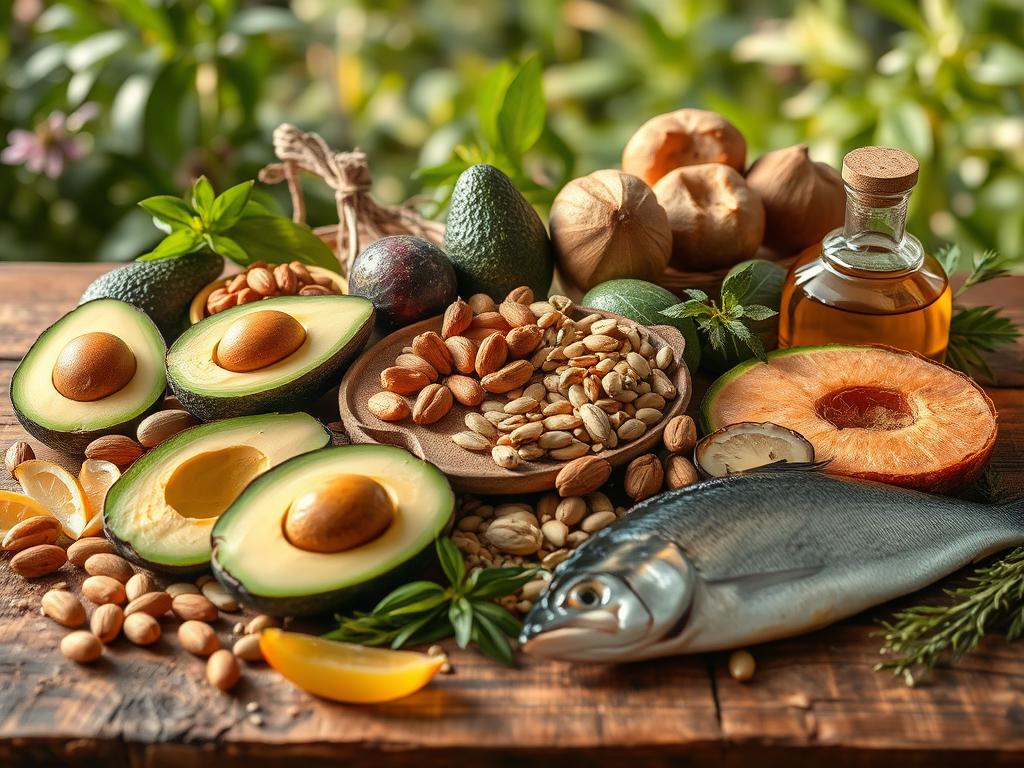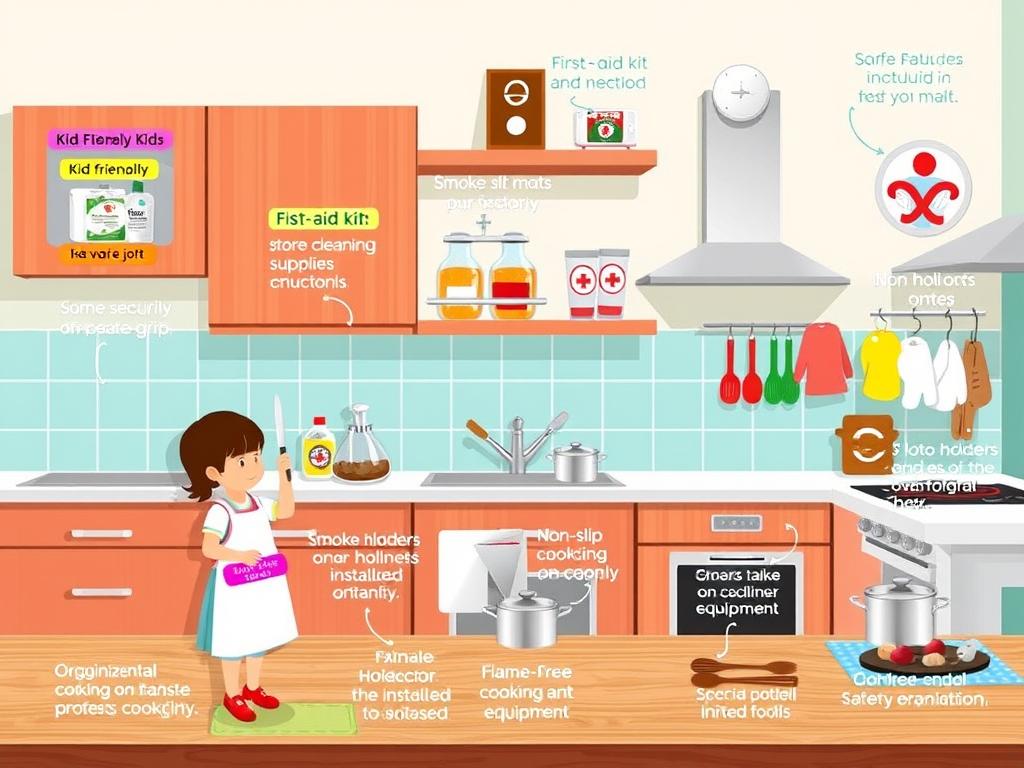There’s something undeniably heartwarming about the scent of roast chicken wafting through your home. Perhaps it takes you back to childhood evenings spent gathered around the dinner table, laughter bubbling over as family enjoyed a meal crafted with love. Learning how to master the perfect roast chicken can evoke those same feelings of warmth and connection. This classic dish has a remarkable ability to bring family and friends together, and achieving the best roast chicken is within your grasp. Whether you’re hosting a special dinner or simply craving a comforting meal, understanding the nuances behind a juicy roast chicken recipe will transform your cooking journey forever.
Key Takeaways
- A 5-pound chicken is ideal for roasting, serving about four people.
- For crispy skin, roast at 425°F; for fall-off-the-bone tenderness, choose 325°F.
- Roasting time varies: at 325°F, allow 1 ½ to 2 hours; at 425°F, 45 minutes to 1 ½ hours.
- Choose fresh herbs like sage, rosemary, and parsley for enhancing flavor.
- Pair your roast with a cup of white wine or chicken broth for delicious pan juices.
Understand the Basics of Roast Chicken
Cooking roast chicken can be a delightful experience, offering a delicious flavor and juicy texture that family and friends will love. Getting the basics right sets the foundation for achieving the best roast chicken, ensuring that every bite is packed with flavor. Starting with selecting the right chicken through the appropriate tools and understanding cooking temperatures will make the process smoother and more enjoyable.
Choosing the Right Chicken
Opt for a whole chicken weighing between 4 to 5 pounds for balanced meat and skin ratios. Choose organic or free-range options for the best flavors. Always remember to check the quality of the chicken and remove any giblets from the cavity before roasting. This will ensure good seasoning and allow the oven roasted chicken to cook evenly.
Important Tools for Roasting
Having the right kitchen tools is essential for a successful roast. Equip yourself with the following items:
- Large cast iron skillet
- Sharp knife
- Kitchen twine
- Baster
- Instant-read thermometer
These tools will help in preparing, cooking, and ensuring the chicken reaches the appropriate internal temperature for safety.
Understanding Cooking Temperatures
Preheat your oven to 425°F for optimal results. This temperature promotes crisp skin and juicy meat. Cooking times generally vary from 70 to 90 minutes depending on the size of the chicken. The goal is to reach an internal temperature of 165°F to confirm it’s fully cooked. Using an instant-read thermometer can help achieve juicy results.
For even moisture, you can add about half a cup of water to the pan if you’re not roasting vegetables. Let the roast chicken rest for at least 15 minutes before slicing; this allows the juices to redistribute, enhancing the flavor and tenderness. Plan to make a simple sauce with the pan drippings, which can be combined with chicken broth and fresh herbs for added flavor. Interested in more tips? Check out this detailed guide on cooking roast chicken.
Essential Seasonings and Marinades
Creating a juicy roast chicken goes beyond just selecting the right bird. The flavors and textures come alive with the right seasonings and marinades. A well-seasoned, flavorful roast chicken can easily become the centerpiece of any meal. Here are some essential ideas for elevating your cooking.
Popular Marinade Recipes
Marinades can drastically improve the taste of your chicken. A delicious blend of olive oil, lemon juice, garlic, and herbs such as rosemary or thyme can transform an easy roast chicken into a culinary masterpiece. Experimenting with a variety of flavors can enhance your dish and make your family dinners memorable. For inspiration on baked BBQ chicken drumsticks, check out this recipe.
Spice Blends for Flavor
Incorporating spice blends is a surefire way to take your chicken to the next level. Consider using smoked paprika, garlic powder, and dried herbs to add depth to your flavorful roast chicken. Each spice brings its unique character, ensuring every bite is packed with taste. Don’t hesitate to mix and match to discover your favorite combinations.
The Importance of Salt
Salt serves as the backbone of flavor in cooking. For juicy roast chicken, it’s crucial to apply kosher salt generously, both inside and outside the bird. This technique enhances flavor while retaining moisture during cooking. Dry-brining the chicken prior to roasting not only seasons it well but also helps achieve that wonderful crispy skin that everyone loves.
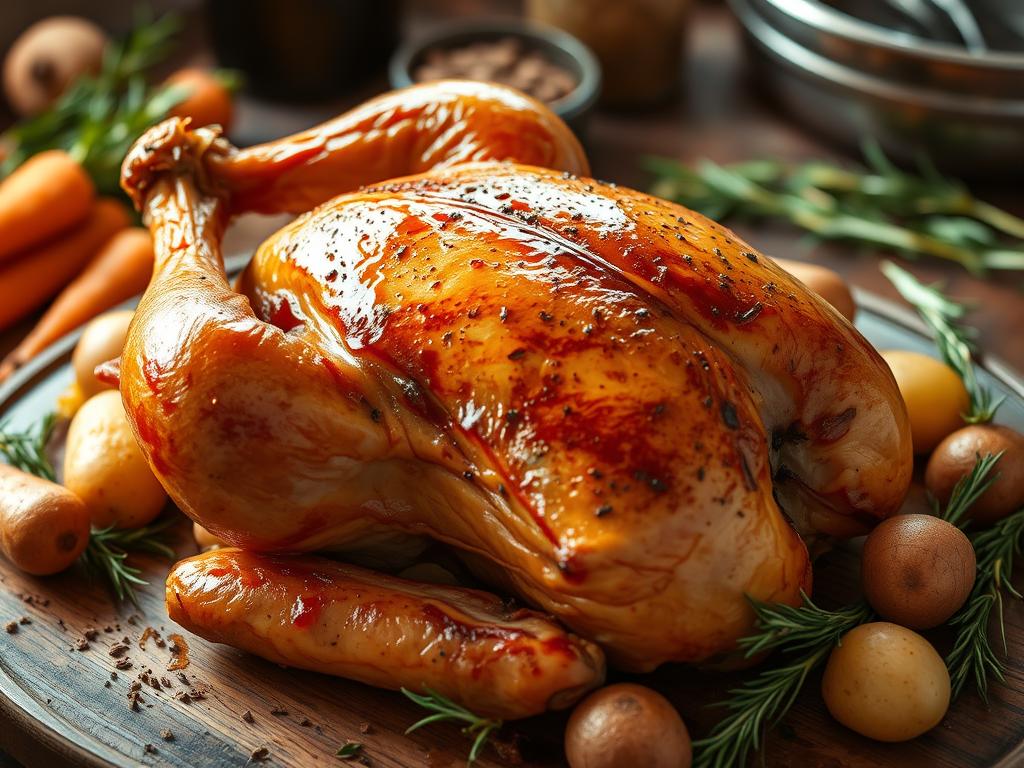
| Ingredient | Function |
|---|---|
| Olive Oil | Adds moisture and richness |
| Lemon Juice | Enhances flavor and tenderizes meat |
| Garlic | Provides aromatic flavors |
| Herbs (Rosemary, Thyme) | Add fragrance and depth |
| Kosher Salt | Enhances overall flavor and moisture retention |
Techniques for Achieving Crispy Skin
To create a beautifully crispy roast chicken, mastering several techniques is essential. These methods focus on preparing the chicken skin and controlling the cooking environment, ensuring maximum texture and flavor.
Drying the Skin
One key step in cooking roast chicken is drying the skin. Prior to roasting, it is crucial to pat the chicken dry with a paper towel or, for enhanced results, air dry it uncovered in the fridge overnight. This process reduces moisture, leading to that sought-after crispy skin.
Basting Methods
Basting adds moisture and flavor during cooking. Basting the chicken with its own juices every 30 minutes aids in retaining the meat’s succulence while elevating crispiness. This technique ensures that the skin gets the attention it needs to turn golden and crispy, making each bite all the more delicious.
Oven Temperature Strategies
Starting at a high temperature is vital for achieving crispy roast chicken. Preheat the oven to about 450°F, which encourages browning. After the initial roasting phase, reduce the temperature to 375°F for the remainder of the cooking time. If the skin begins to darken too quickly, tent the chicken loosely with foil to prevent burning while still allowing it to crisp up nicely.
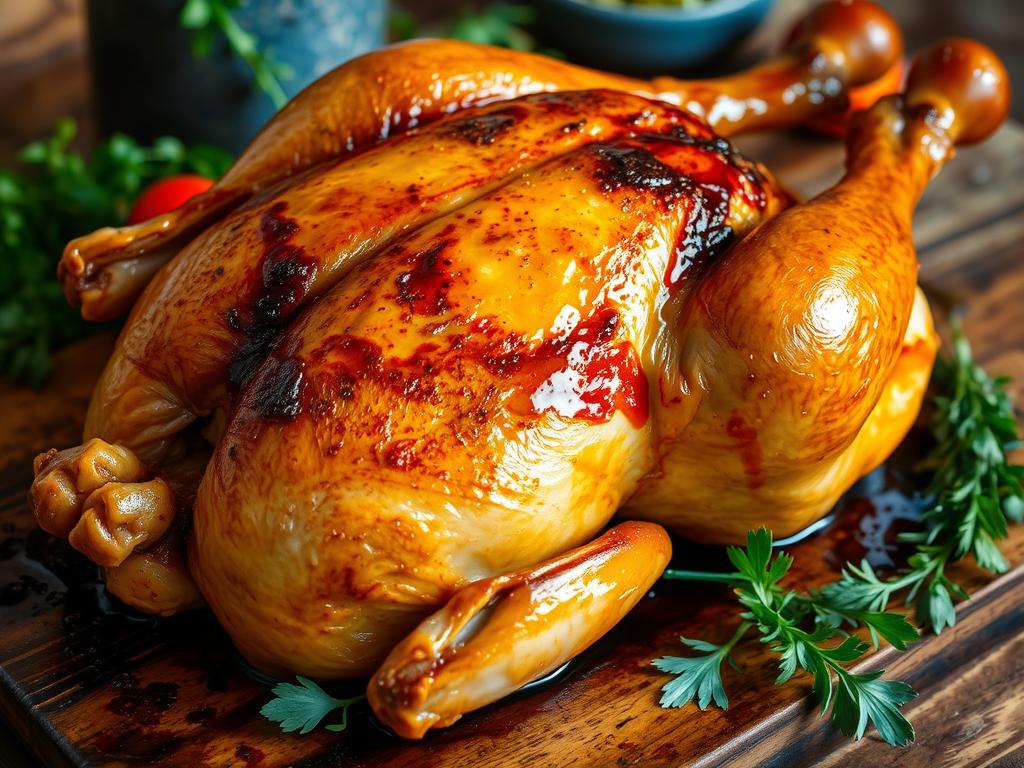
Incorporating these techniques not only enhances the texture but also results in a flavorful dish that impresses. The right balance of preparation and attention during cooking makes all the difference in producing that perfect crispy roast chicken. For a delightful twist on flavor and texture pairings, check out this resource for additional ideas.
| Technique | Description | Benefits |
|---|---|---|
| Drying the Skin | Patting or air drying chicken to remove excess moisture | Enhances skin crispiness |
| Basting | Basting with juices every 30 minutes | Retains moisture and adds flavor |
| Oven Temperature | Starting at 450°F, reducing to 375°F | Promotes browning and even cooking |
Sides and Pairings for Roast Chicken
A perfect roast chicken recipe deserves equally delicious sides to elevate the dining experience. Selecting the right accompaniments can enhance the flavors and create a well-rounded meal. Whether planning a simple family dinner or a festive gathering, these side dishes will complement your crispy roast chicken beautifully.
Classic Side Dishes
Some classic pairings that never go out of style include:
- Mashed potatoes
- Glazed carrots
- Fresh green salad
- Roasted Brussels sprouts
- Baked asparagus
- Sautéed green beans
These simple yet flavorful options enhance the savory profile of roast chicken, making dinner a satisfying affair.
Creative Flavor Combos
For those looking to explore new tastes, consider these exciting ideas:
- Ratatouille – a colorful dish that adds depth
- Confit Bayaldi – rich in flavor and texture
- Roasted butternut squash quinoa salad – features fluffy quinoa and pomegranate
- Hasselback sweet potatoes topped with bacon maple brown butter – a fall favorite
- Roasted vegetables like pumpkin and sweet potatoes
- Smashed potatoes for a chunky alternative
These vibrant dishes introduce various flavors and make every bite exciting, perfect for your roast chicken recipe.
Wine Pairing Suggestions
To further enhance your meal, consider the following wines:
- Chardonnay
- Sauvignon Blanc
- Champagne for a celebratory touch
- Pinot Noir to complement savory flavors
- Viognier for a fruity twist
These wines not only elevate the experience but also bring out the richness of the crispy roast chicken, making for an unforgettable dining occasion.
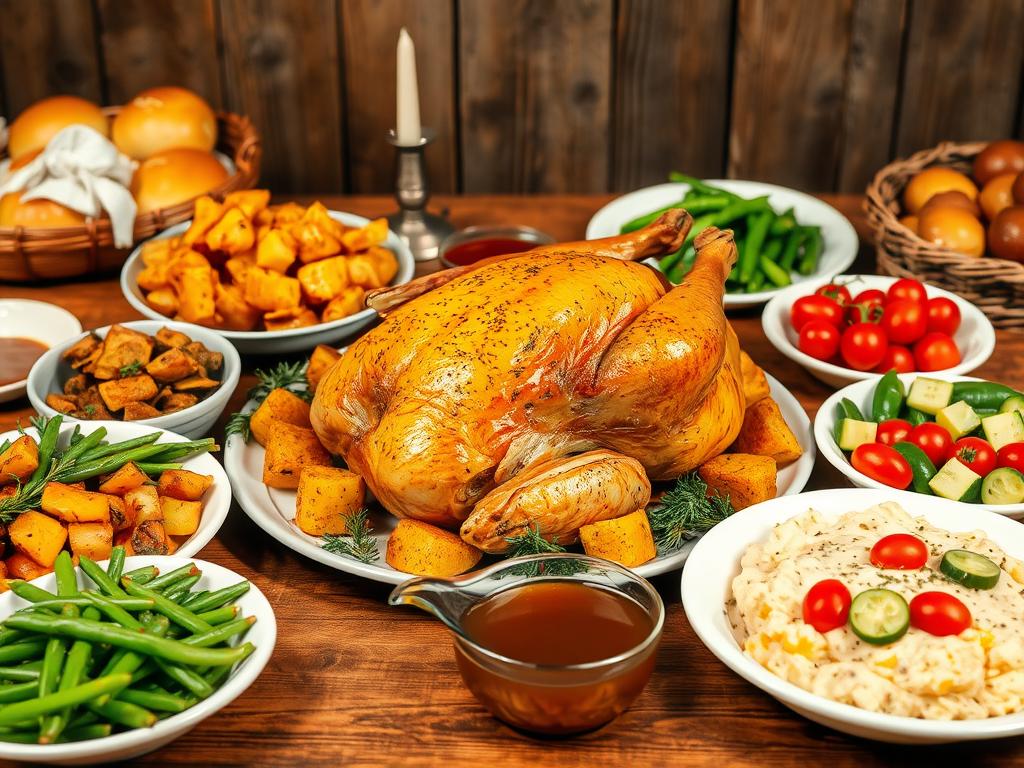
Troubleshooting Common Roast Chicken Issues
Even the most skilled cooks can encounter issues when preparing a juicy roast chicken. Understanding how to troubleshoot these common problems is essential for achieving that perfect roast every time. Whether it’s dealing with overcooking or ensuring the skin crisps beautifully, knowing the reasons behind these challenges can make all the difference.
Overcooking and Dryness
To prevent overcooking and ensure your chicken remains juicy, using a meat thermometer is vital. Remove the chicken from the oven when the internal temperature reaches 165°F. Allow it to rest for about 20 minutes before serving to maintain its moisture—a crucial step for mouthwatering results.
Underseasoning Solutions
If your roast chicken lacks flavor, consider extending the marination time or applying a heartier seasoning. Aromatics like garlic and herbs inside the cavity can elevate the taste significantly. Incorporating the right amount of salt not only enhances flavor but also contributes to crispy skin, making it a key factor in troubleshooting roast chicken.
Skin Not Crisping? Here’s Why!
The lack of crispiness can often be attributed to moisture. Make sure to dry the chicken thoroughly before seasoning, and avoid covering it while roasting, as this can trap steam. An oven temperature of 450°F initially, then reducing to 400°F, will help achieve that sought-after crispy skin. For more delightful ideas on enhancing meals, explore sections on fun snacks like honey-roasted almonds.





